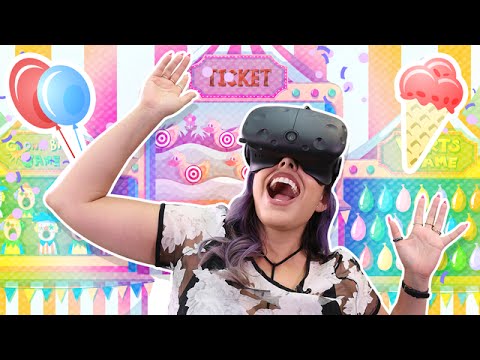Beginner's guide to getting into VR games, movies, and apps 2021
Interested in VR, but unsure of where to begin? We have a guide that can help with this.
Once it's picked up steam, it's difficult to catch up with a technique. It seems like everybody knows every little detail about it, and learning the ropes can be almost impossible if you can't find a welcoming community.
That's what happened to virtual reality for some folks. A technology that went overnight from stupid retro tech to a development kit to a full-blown cultural phenomenon.
Do not worry if you missed the first four years of VR's rise to prominence. The software is less complex than you think and is super simple to comprehend. There are affordable ways to try it before you buy it, and if you've already purchased a headset, there are many ways to find new content.

Not sure where to begin on the edge of digital and physical spaces in this wondrous world?
Let us be your virtual tour guides, as we take you through the technology step-by-step.
What is the reality of virtual reality? How is a computer or a TV different from that?
We're talking about images, videos, games or software that offers a 180-degree or 360-degree field of view when we speak about virtual reality. It's material that you can first-hand explore or experience, getting closer than ever before.
When most people think about VR, 3D is their first thought, the display technology that used stereoscopy to give the illusion that images were popping out of the screen. VR is similar in that it sometimes uses tricks to add realism to the content, but it does not stop where the screen stops, filling an image or environment with your entire field of view.
There are apps that put you in a shark cage instead of looking at a shark on the Discovery Channel and allow you to experience what it would be like to see the animals around you swimming.
It is because the content feels more immersive why people like it so much. There are apps that put you in a shark cage instead of looking at a shark on the Discovery Channel and allow you to experience what it would be like to see the animals around you swimming. It's the first step toward the holo deck you saw 40 years ago on Star Trek.
Now in VR, not every video or video game ever produced is accessible, at least not natively. When the content generated for virtual reality, VR works best and viewed on a headset of virtual reality... even a cheap one like Google Cardboard.
Just as every YouTube video is not an Oscar-award winning production, the quality of this content varies wildly, but the central idea behind it all is that it is more immersive than 2D.
Healthy using VR? can you get hurt?
The consensus is that, yes; it is completely safe to use, especially for adults whose eyes have stopped developing already and who are not really sick with motion. Whether it is safe for children aged 13 and under remains a topic of debate, but most businesses recommend limited use with plenty of breaks for the age group.
In fact, we recommend slowly getting acclimatized, even for adults just getting into the medium. Just to get your eyes used to having a screen that close by, put the headset on for a few minutes at a time and then take it off.
Wearing a headset for an hour or more puts some strain on your eyes, and if you're not properly hydrated or motion sickness, it can cause headaches if the content you're watching moves in a way that your body feels unnatural.
That said, the most dangerous part of VR is probably eye fatigue. Wearing a headset for an hour or more puts some strain on your eyes, and if you're not properly hydrated or motion sickness, it can cause headaches if the content you're watching moves in a way that your body feels unnatural. Neither is permanent, though, and once you take the headset off, both should subside fairly quickly.
Just as it's important to take breaks to clear the surrounding space while using a VR headset, there's no way to see what's going on around you unless you're using the pass-through cameras on the headset, so if you're playing in a furnished room, it's incredibly easy to travel and fall. Before you play, most PC headsets will ask you to set up boundaries that prevent you from walking into anything, but usually the more empty the play space is, the safer it will be for you.
What is the difference between the headsets?
They usually fall into three categories when we talk about headsets: PC-tethered headsets like the Oculus Rift and Valve Index, mobile-powered headsets like the Samsung Gear VR and standalone headsets like the Oculus Quest. There's also one VR headset based on the console called PlayStation VR that plugs right into your PS4.
Usually, PC-tethered headsets look the best, feel the most immersive and offer the greatest variety of experiences. Typically, they're also the most costly, too. They operate by plugging the headset into your computer's USB and Display port/HDMI ports and installing specific software, such as SteamVR or the Oculus app. Specific controllers and tracking stations most often come with them, but that's not always the case and each headset is different.
When Samsung gave them away with the acquisition of a new phone back in 2017, mobile-powered headsets were the first to market and gained popularity. They work by slotting your phone into the headset and strapping it to your face, as you would expect. The experiences on this platform are not as immersive or as good-looking as the ones on PC-tethered headsets you'd find, but if you're not sure about VR, they're a good starting point.
Last but not least, there are standalone headsets that build everything you need into the headset itself, so you can essentially unbox it in minutes and be ready to play. We like these because they provide a happy medium between price and performance and offer most of the same experiences on PC-tethered headsets you would find. Heck, Oculus even gives you the option to plug the Quest via the Oculus Connect Cable into your PC, so it's also the most flexible option.
It's worth looking at the specific specs each headset offers once you've decided what kind of headset you want. Resolutions (how many pixels are on the screen), view fields (how much you can see at once), frame rates (how smooth the content is) should be compared, and how the headset tracked, either with discrete base stations or through built-in cameras.
So, do you ever need a headset? Well, if you want the experience to be complete, yes. But if you just want to watch VR videos to see what you're missing, on your mobile phone and PC, YouTube, Facebook and many other sites have the option to view 360-degree videos. Plunking no money down, this may be a good first step into the world of VR.
What is the content type out there?
Not sure where to begin? Look at our best VR games, best PSVR games, and best VR headsets lists.
This question is a kind of enjoyment asking "what type of content on the internet is out there?" The answer is, well, a lot of stuff! However, you will use a VR headset for the vast majority of the time to watch VR videos such as 360-degree concerts or art installations or roller coaster rides, and play Oculus and Steam VR games.
You could use it to hold virtual meetings where you bring in 3D assets for everyone to look at or use the headset for specific training simulations if you're an enterprise user or you need a VR headset for work. Educators could use it to bring their lessons to life through interactive experiences for their students, and as more embrace VR as a new form of entertainment, you could even try a headset on inside amusement parks.
The content pool is as broad as you'd expect it to be. There's a lot out there, and in a day there's no way to see it all.
So how many does it cost for this content? Well, it varies. Lots of these videos on YouTube and Facebook are free, as are the apps you used to view them, such as Gizmo and Oculus Video. There are also several free demos of VR games and several free VR educational apps that are available to try. Without spending a dime at all, you can get reasonably far.
That said, premium content such as AAA games or longer VR experiences costs cash, all the way from $10/£10 to $60/£60.
The good news is that there are several subscription services such as Vive port Infinity out there that allow you to download several games for a monthly fee, and many of the online stores where you buy games and experiences often sell the most popular content with massive discounts.
Should a VR headset purchased?
I hope you'll be able to answer this one yourself by now. If you're the person who likes to be at the groundbreaking of technology and who has the time to dig into new experiences, then yes, it's worth diving into VR altogether. But if you're strapped on time and money, and you're not sure that VR is right for you, watch a few VR videos on your phone to get an experience preview or buy a cheap VR headset that if it sits on the shelf, you won't feel bad.
Personally, once a week, we use our VR headsets, typically to try the latest VR marquee game or catch up on cool new videos. Some people use it as their primary way of playing games every day, while some might use it much less. Everything depends on you, your timetable, and your interest in the platform.
But hopefully you've got a better idea now of what to expect from VR and how different it is.
Virtual Reality, Augmented and Artificial Intelligence 2021 specialist Amit Caesar wrote the article.
Private customers can purchase virtual and augmented reality products on the world's well-known and largest sites:

You should also check out the following articles:
- VR BUYING GUIDE AND THE BEST VR HEADSET FOR 2022
- A meta market opportunity: The metaverse could soon be worth $1 trillion
- Facebook wants to build a metaverse. Microsoft is creating something even more ambitious.
- How to succeed in the virtual reality world of tomorrow?
- Books you must read about virtual reality
- Best New Augmented Reality Books To Read In 2021
- US$ 4.7 Billion- The global augmented reality gaming market
- The smart glasses revolution is about to get real
- Consumer Brands Reinventing Marketing in the Metaverse
- Imagine Making Money in Rec Room
- The biggest AR and VR predictions of 2022
- Apple hired Meta's AR communications lead ahead of the 2022 launch of the headset.
- Who Will Be in Charge of the Metaverse?
- The Kingdom of Abraham: The first Jewish metaverse
- Gen Z are planning to spend thousands on cryptocurrency, NFTs and metaverse
- According to Goldman Sachs, the metaverse must run on blockchain
- What You Can Create With a Small Piece of Land in the Metaverse
- How To Buy Land In The Metaverse?





